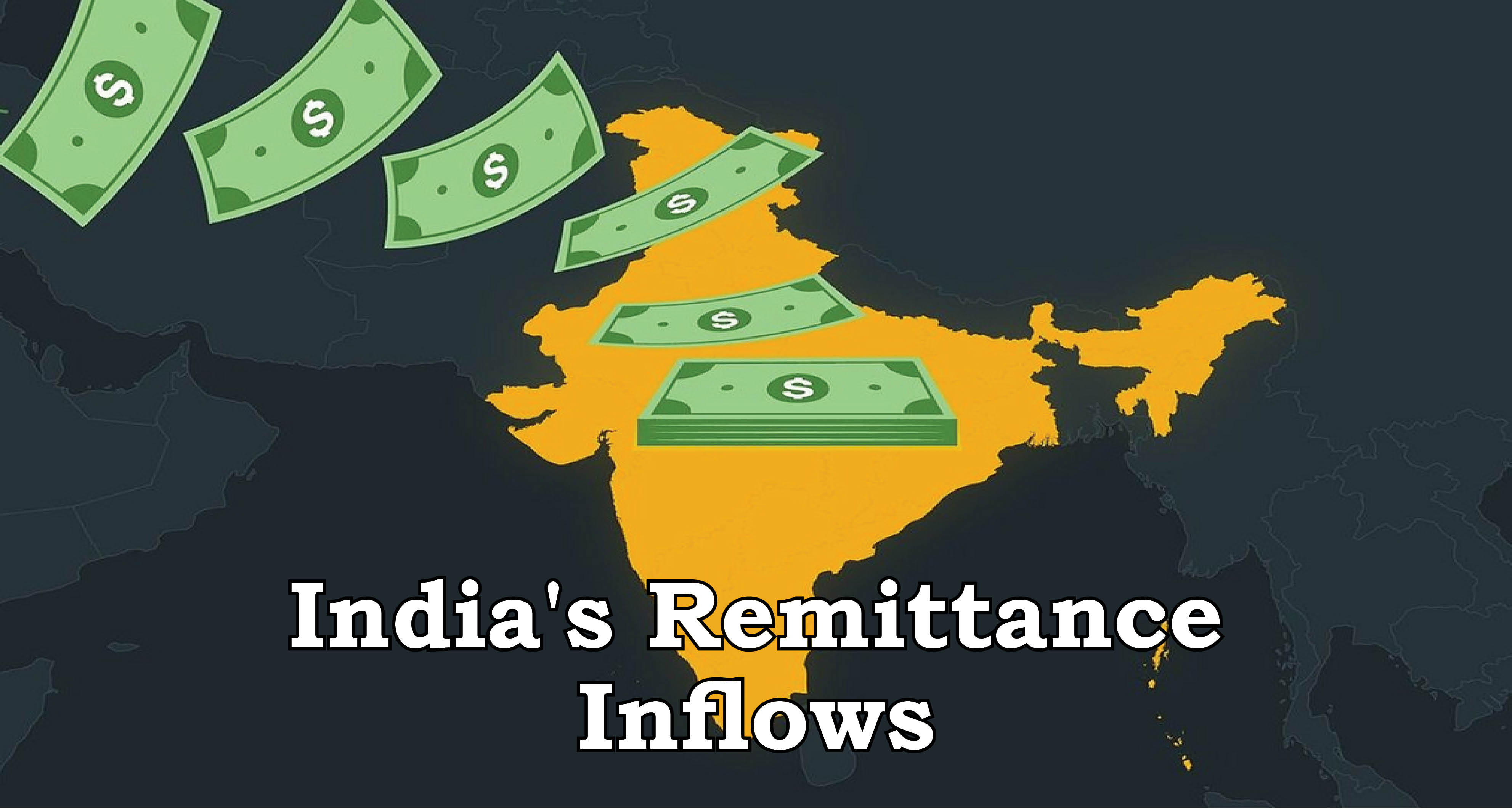Introduction
India has long been one of the world’s largest recipients of remittances, with millions of Indian migrants sending money back home. However, the latest Remittances Survey (2023-24) by the Reserve Bank of India (RBI) highlights a major shift in India's remittance inflows. For the first time, remittances from Advanced Economies (AEs)—including the United States, the United Kingdom, Canada, Singapore, and Australia—have surpassed those from the Gulf Cooperation Council (GCC) nations (Saudi Arabia, the UAE, Qatar, Oman, Bahrain, and Kuwait).
This shift is not merely a statistical change; it reflects broader transformations in global migration patterns, employment opportunities, and economic policies. The decreasing reliance on remittances from the Gulf and increasing inflows from high-income countries indicate a transition from low-wage, volume-driven remittances to high-value remittances from skilled professionals in AEs.
While this development strengthens India's economic resilience, it also raises critical policy questions regarding migration trends, labor market dynamics, and the sustainability of remittance inflows. A deeper understanding of these trends is essential for designing policies that support migrant workers and maximize remittance benefits for India’s economy.
Declining Remittances from the Gulf: Causes and Implications
Historically, the GCC nations have been the largest contributors to India’s remittance economy, largely due to the significant number of Indian blue-collar workers employed in the region. However, recent data indicate a decline in remittance inflows from the Gulf. Several factors contribute to this trend:
1. Economic Disruptions Due to COVID-19
The COVID-19 pandemic had a severe impact on the Gulf economies, leading to:
- Widespread job losses among Indian migrant workers.
- Salary reductions, limiting the disposable income available for remittances.
- Temporary return migration, as many workers were forced to return to India due to job losses.
2. Nationalisation Policies in the GCC
Several GCC nations have introduced labor nationalisation policies aimed at reducing foreign worker dependency and increasing local employment.
- Saudi Arabia’s "Saudisation" (Nitaqat) policy prioritizes Saudi citizens in private-sector jobs.
- The UAE’s "Emiratisation" strategy has similarly encouraged businesses to hire local talent over foreign workers.
These policies have significantly reduced employment opportunities for Indian migrants, leading to lower remittances from these regions.
3. Declining Share of GCC Remittances
The shift in economic and labor policies has led to a noticeable decline in the share of remittances from GCC countries:
- UAE’s share in total remittances dropped from 26.9% (2016-17) to 19.2% (2023-24).
- Saudi Arabia’s share fell from 11.6% to 6.7%.
- Kuwait’s share declined from 6.5% to 3.9%.
Future Outlook for GCC Remittances
Despite these trends, remittance inflows from the Gulf could recover if economic conditions stabilize and labor policies evolve to accommodate skilled foreign workers. However, the overall trajectory suggests a shift away from low-skilled labor migration toward high-skilled professional migration to advanced economies.
Increasing Remittances from Advanced Economies (AEs): Causes and Impact
While remittances from the Gulf have declined, remittances from Advanced Economies (AEs) have been steadily increasing.
1. United States as the Largest Contributor
- In 2023-24, the US accounted for 27.7% of India’s total remittances, up from 22.9% in 2016-17 and 23.4% in 2020-21.
- Although the total number of Indian migrants in the US is smaller than in the Gulf, they send higher per capita remittances due to higher wages and greater purchasing power.
2. Growth of Remittances from Other AEs
- UK’s share increased from 3% (2016-17) to 10.8% (2023-24).
- Canada’s share rose from 3% to 3.8%.
- Singapore’s share grew from 5.5% to 6.6%.
3. Factors Driving Higher Remittances from AEs
a) Higher Incomes and Purchasing Power
- Indian professionals in STEM (Science, Technology, Engineering, Mathematics), finance, and healthcare earn significantly higher salaries in AEs compared to the Gulf.
- Stronger exchange rates in AEs (especially the US dollar) increase the real value of remittances.
b) Changing Migration Patterns
- Highly skilled Indian professionals are increasingly migrating to countries like Germany, the Netherlands, and Australia in search of better opportunities.
- These workers typically remit more money home, boosting India’s remittance inflows.
c) Uncertainty in Immigration Policies
- Right-wing politics in several AEs have led to restrictive immigration policies, making it harder for migrants to secure permanent residency.
- This uncertainty has led many Indian migrants to remit larger sums home rather than investing in their host countries.
Role of Indian Students in Remittance Growth
1. Growing Student Migration: A significant portion of India’s remittance inflows now comes from Indian students pursuing higher education abroad.
- Students contribute to remittance inflows through loan repayments and family financial transfers.
2. Challenge of Deskilling and Underemployment: Many Indian students in Canada and the UK face “wilful deskilling”, where highly educated graduates are forced to take low-skill jobs (retail, hospitality, delivery services) to qualify for permanent residency.
- This restricts their long-term earning potential, affecting future remittance inflows.
3. Impact of Changing Visa Policies: Sudden visa rule changes in countries like Canada and Australia impact students’ career prospects, affecting their ability to send remittances home.
Future Trends in India’s Remittance Economy:
1. Potential Increase in Remittances from AEs: As skilled migration increases, remittances from AEs (especially the US, UK, and Canada) will continue to grow.
2. Possibility of Return Migration to India: If immigration policies become more restrictive, some Indian professionals may return to India, bringing their financial assets and remittances with them.
3. Stabilization of Gulf Remittances: Economic recovery in the GCC region could revive employment opportunities and stabilize remittance inflows from the Gulf.
Policy Recommendations for Maximizing Remittance Benefits
1. Skill Harmonization and Migration Policies: India should align its education and skill development programs with the global labor market, ensuring that Indian workers secure jobs that match their qualifications.
2. Preventing Deskilling of Indian Students Abroad: The government should negotiate with host countries to ensure that skilled Indian graduates can access jobs relevant to their expertise.
3. Investment Incentives for Returning Migrants: India should encourage returning migrants to reinvest in the domestic economy, ensuring that remittances contribute to long-term economic growth.
Conclusion
India’s remittance landscape is undergoing a fundamental shift, moving away from Gulf-based, low-wage remittances to high-value inflows from skilled professionals in AEs. This transition presents both opportunities and challenges. While it strengthens India’s economy, it also demands strategic policy interventions to maximize remittance benefits and support migrant workers. By addressing skill gaps, immigration policies, and labor market integration, India can ensure that remittances continue to be a driving force for economic development.
| Main question: India’s remittance landscape is evolving from low-wage remittances from the Gulf to high-value inflows from Advanced Economies. What strategic policy interventions can India undertake to maximize the benefits of remittances and ensure sustainable economic development? (250 words) |









